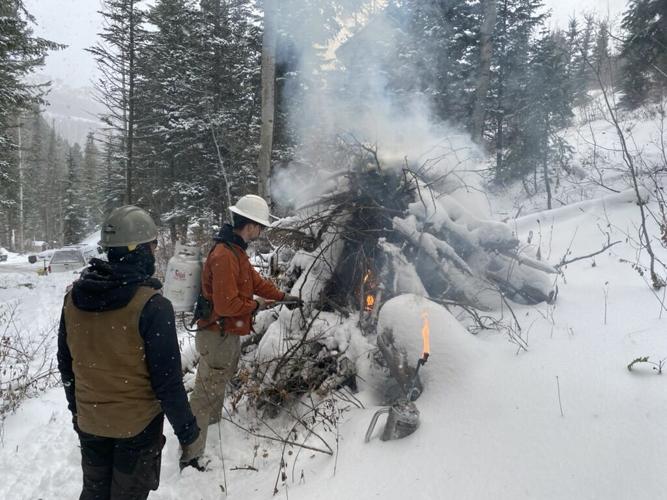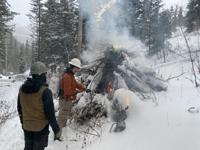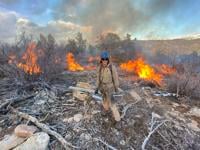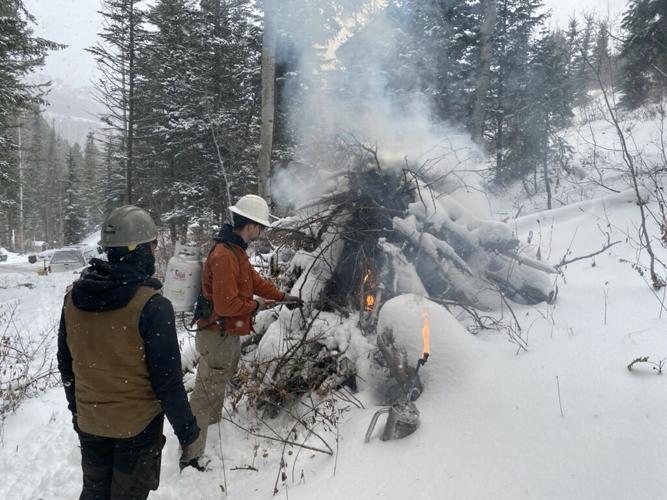Fire personnel from the Ogden and Logan Ranger Districts burned up to 130 acres of slash piles Tuesday, about 45 miles east of Logan.
According to North Zone Fire Management Officer Jeff Sanocki, residual smoke from the pile burning project may be visible for a few days until it snows again.
Sanocki said the burn went well. There are no more planned burns for the Logan Ranger District for this fall, but Sanocki said there is a chance more will be scheduled as logging operations continue.
In a press release, Utah Prescribed Fire Council Chair J. Bradley Washa explained why pile burning is becoming more common around the state.
According to Washa, wildland fires have not occurred for up to 150 years in some areas around Utah, resulting in a buildup of fuels. Because of this, when wildfires occur in those areas, they are more severe, and more acres are burned.
Thinning forest and brush vegetation, piling the cut material and burning the piles is one way to mimic a wildland fire.
Washa said piling and burning can be costly, but it can also be cost-effective compared to other treatment methods like removing fuels or chipping. He said it often occurs in areas where people have built homes in forests, “where the leaves meet the eaves.”
One concern people have about pile burning is the smoke.
Washa wrote that many steps are taken to minimize smoke and lower emission rates.
He said burners work with the Utah Division of Air Quality to meet regulatory requirements, such as when the lifting and dispersion of smoke will be optimal. Pile burning typically occurs earlier in the day, so the piles will burn down before the air stabilizes in the evening.
A study comparing air quality and health impacts of wildfires and prescribed fires estimated emissions from wildfires to be two to 18 times greater than prescribed fires.
The study also found air quality impacts of wildfires occur on a much larger scale compared to prescribed fires.
“While these short-term exposures from prescribed burning can be inconvenient and irritating, the long-term exposure from wildfire smoke is more concerning, as seen this summer when smoke from wildfires as far away as Canada impacted Utah,” Washa wrote.
Washa said pile burning throughout Utah is planned for the fall as conditions allow, with snow on the ground or enough moisture to limit any fire spread from the pile.
Pile burning is conducted by federal, state and local agencies, homeowner associations, private landowners and companies specializing in forestry and wildland fire management. Various state and local rules may apply. Washa said to contact your local county fire warden or fire department for specifics on pile burning in your area.
USU Wildland Fire Club
Washa is also a Utah State University Extension assistant professor of wildland fire science.
He is involved with the USU Wildland Fire Club, a part of the Wildland Resources Department within the Quinney College of Natural Resources. Last year, 14 students from the club went to the Park City area on three separate occasions to burn piles in the Pinebrook neighborhood.
“This is a great opportunity to get hands-on fire experience while learning about the ecological, environmental, and social aspects of natural resource management,” Washa said.
Washa said while the Yellow Lake Fire was burning east of Heber City, several of the students went to look at the incident command post and got a first-hand look at the strategies and tactics used on a wildfire.
He said in the spring, USU will offer a course that gives individuals the qualifications they need to become a certified wildland firefighter.
Washa said pile burning can effectively address the three parts of the National Cohesive Wildland Fire Management Strategy: 1) Developing fire-wise communities, 2) Creating fire-resilient landscapes, and 3) Providing a safe and effective wildfire suppression response.
“As communities conduct fuel management and burn piles, they support the fire-wise model,” Washa wrote. “Mimicking a wildfire by thinning, piling and burning helps ensure that when a wildfire burns through the area, the residual trees will have a better chance of surviving a wildfire and minimizing other disturbances to the landscape, such as erosion.”
















(0) comments
Welcome to the discussion.
Log In
We welcome comments, however there are some guidelines:
Keep it Clean: Please avoid obscene, vulgar, lewd, racist or sexual language. Don't Threaten: Threats of harming another person will not be tolerated. Be Truthful: Don't lie about anyone or anything. Be Nice: No racism, sexism or any sort of -ism that is degrading. Be Proactive: Report abusive posts and don’t engage with trolls. Share with Us: Tell us your personal accounts and the history behind articles.